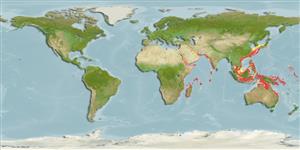Environment: milieu / climate zone / depth range / distribution range
Ecología
marino demersal; rango de profundidad 37 - 137 m (Ref. 4417). Tropical
Indo-West Pacific: South Africa (based on a juvenile specimen), India, Celebes and possibly Hong Kong and Taiwan.
Tamaño / Peso / Age
Maturity: Lm ? range ? - ? cm
Max length : 8.0 cm SL macho / no sexado; (Ref. 9824)
Espinas dorsales (total): 0; Radios blandos dorsales (total): 78-85; Espinas anales 0; Radios blandos anales: 60 - 67. Eyed side brownish; both eyed and blind sides with dark blotches on edges of body, dorsal and anal fins; 2-3 dark blotches on lateral line; pectoral fin of eyed side with dark area and 11-13 rays; pectoral fin on blind side with 11-12 rays; caudal fin with broad dark band; (Ref. 4417).
Found on sand and shell bottoms. Feeds on small benthic animals (Ref. 9824).
Life cycle and mating behavior
Madurez | Reproducción | Puesta | Huevos | Fecundidad | Larva
Hensley, D.A., 1986. Bothidae. p. 854-863. In M.M. Smith and P.C. Heemstra (eds.) Smiths' sea fishes. Springer-Verlag, Berlin. (Ref. 4417)
IUCN Red List Status (Ref. 130435)
Threat to humans
Harmless
Human uses
Pesquerías: sin interés
Más información
Nombres comunesSinónimosMetabolismoDespredadoresEcotoxicologíaReproducciónMadurezPuestaAgregación para la puestaFecundidadHuevosEgg development
ReferenciasAcuiculturaPerfil de acuiculturaRazasGenéticaElectrophoresesheritabilidadEnfermedadesProcesamientoNutrientsMass conversion
Herramientas
Special reports
Download XML
Fuentes de Internet
Estimates based on models
Preferred temperature (Ref.
123201): 21.9 - 28.1, mean 26.5 °C (based on 277 cells).
Phylogenetic diversity index (Ref.
82804): PD
50 = 0.5010 [Uniqueness, from 0.5 = low to 2.0 = high].
Bayesian length-weight: a=0.00912 (0.00408 - 0.02036), b=3.05 (2.87 - 3.23), in cm total length, based on LWR estimates for this (Sub)family-body shape (Ref.
93245).
Nivel trófico (Ref.
69278): 3.5 ±0.37 se; based on food items.
Resiliencia (Ref.
120179): Alto, población duplicada en un tiempo mínimo inferior a 15 meses (Preliminary K or Fecundity.).
Fishing Vulnerability (Ref.
59153): Low vulnerability (10 of 100).
